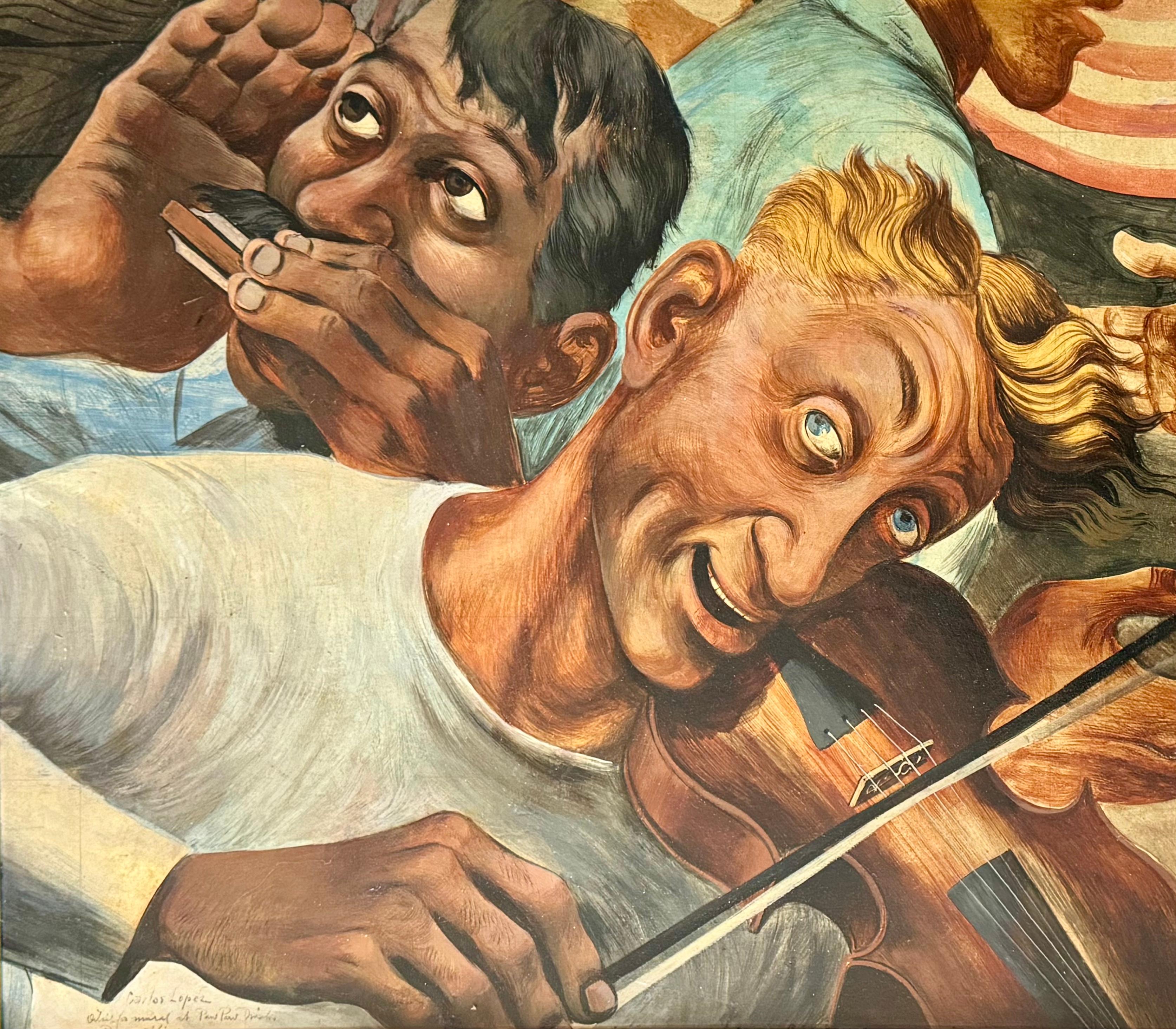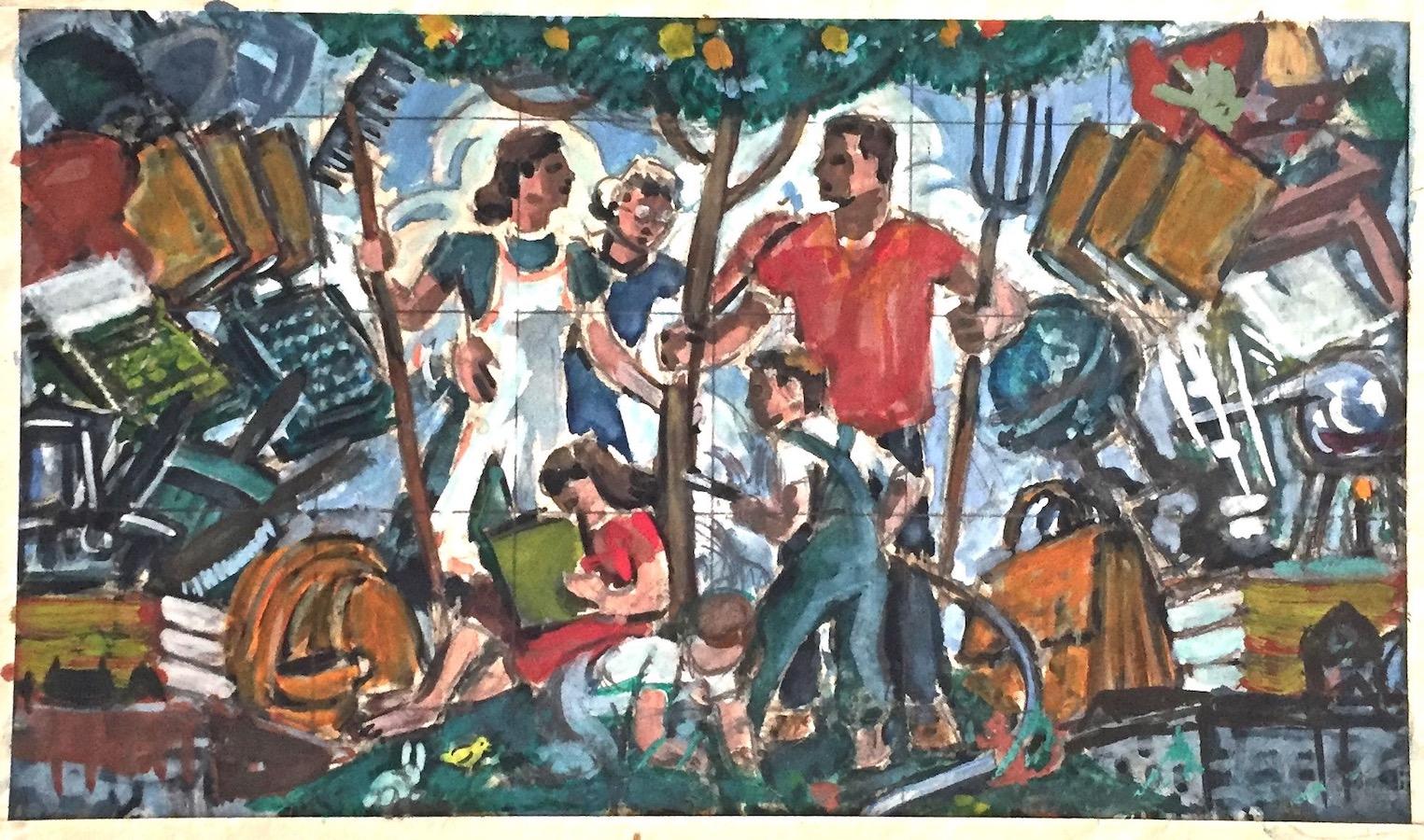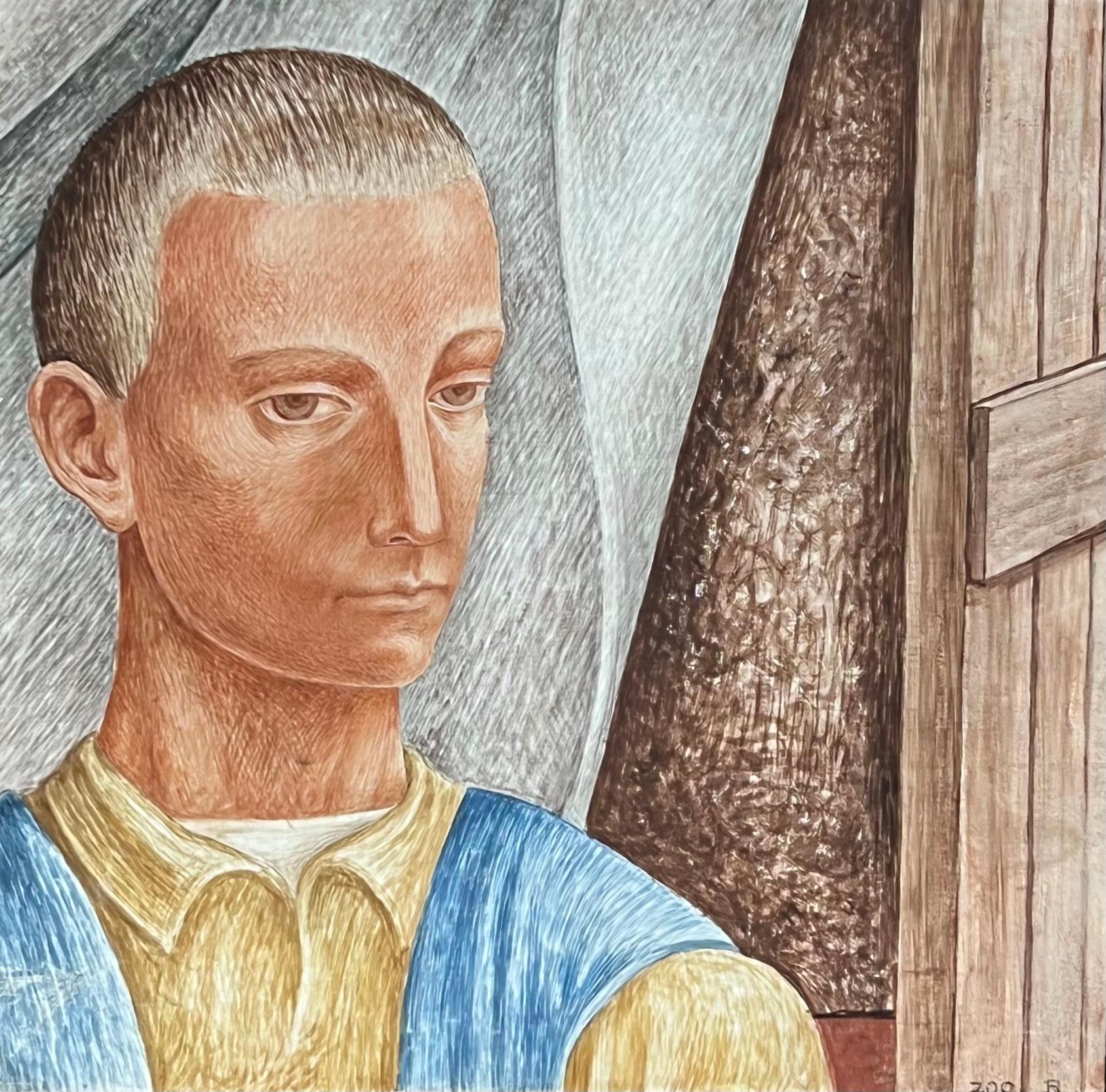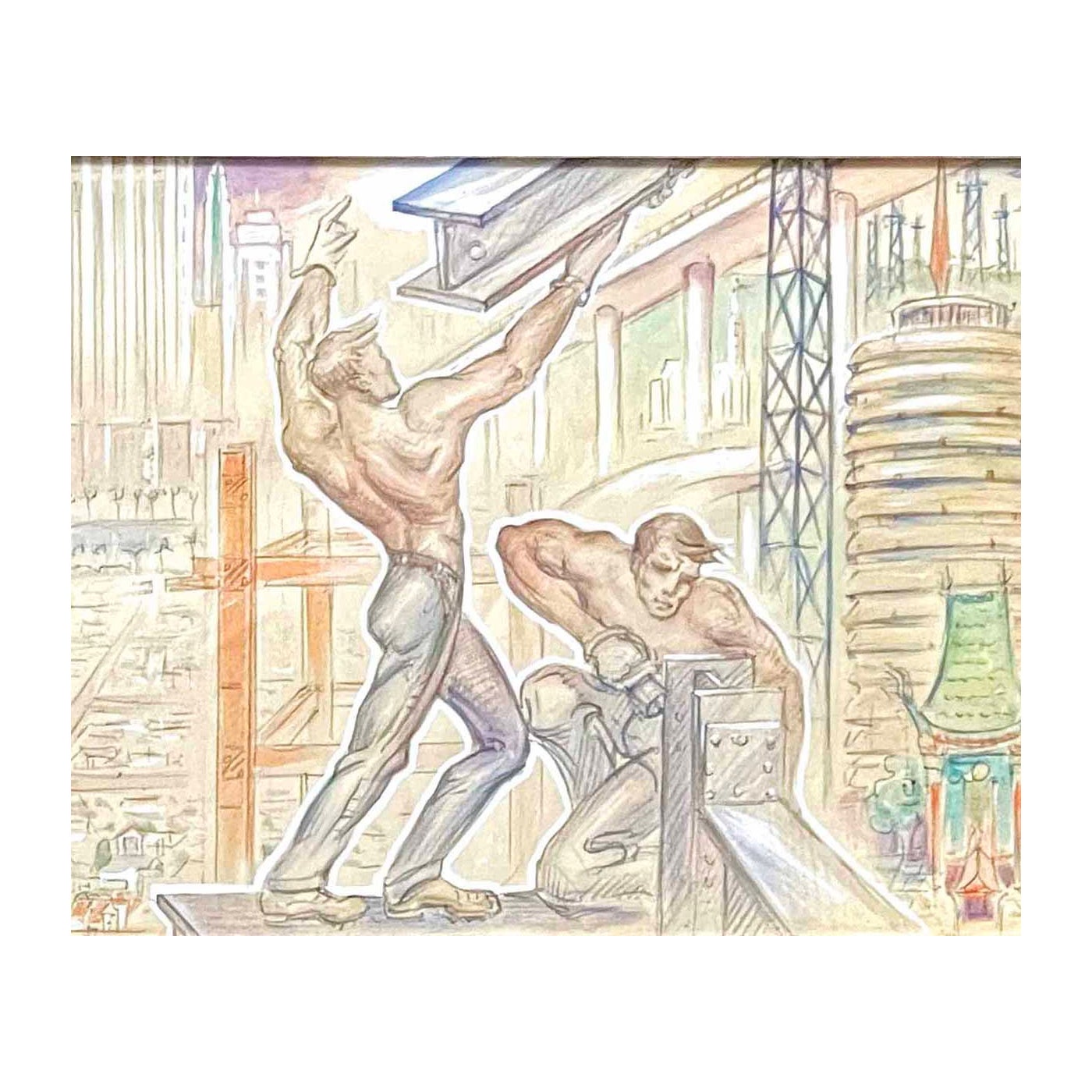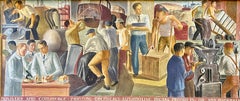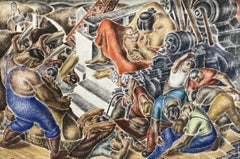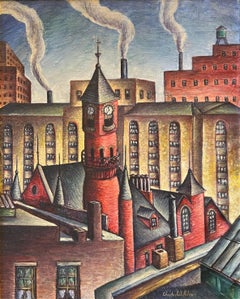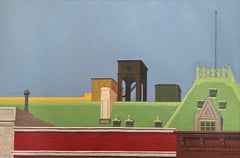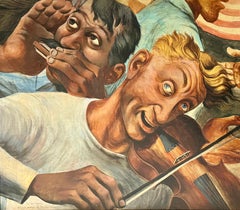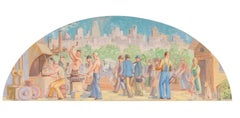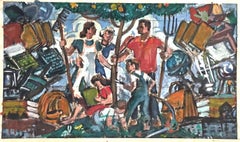Items Similar to San Pedro Post Office: History of Writing Mural South, Preliminary Mural Study
Want more images or videos?
Request additional images or videos from the seller
1 of 5
Edward BibermanSan Pedro Post Office: History of Writing Mural South, Preliminary Mural Studyc. 1936-7
c. 1936-7
$27,500
£21,165.58
€24,103.84
CA$39,095.30
A$42,497.91
CHF 22,272.65
MX$517,235.77
NOK 280,359.47
SEK 263,446.67
DKK 180,007.65
About the Item
This mural study is part of our exhibition America Coast to Coast: Artists of the 1930s
San Pedro Post Office: History of Writing Mural South, Preliminary Mural Maquette right panel, 1936-7 mixed media on paper mounted on masonite, 20 x 41 inches (image), 30 x 52 inches (framed); exhibited in Lost Horizons: Mural Dreams of Edward Biberman, Los Angeles County Museum of Art at SPARC's Duron Gallery from May 31 to August 29, 2014; illustrated in i) the catalog for the foregoing p. 22; and ii) (film) Kaufman, Jeffrey, Brush with Life: The Art of Being Edward Biberman, 2007, (DVD release 2010), 85 minutes; provenance estate of the artist; presented in newer frame from the 2014 LACMA/SPARC exhibition
About the Painting
Even before the creation of the WPA and the Treasury Department Section of Fine Arts, Biberman was known as a mural painter, having been selected for inclusion in one of the Museum of Modern Art’s early exhibitions in 1932, Murals by American Painters and Photographers. Around the same time, he also joined the National Society of Mural Painters. While in New York, Biberman lectured on muralism, taught classes on mural techniques and knew, admired, and drew lessons from Los Tres Grandes, the Mexican muralists, Orozco, Rivera, and Siqueiros. By his own reckoning, Biberman competed for seven or eight Federal Government mural projects during the 1930s and early 1940s. In addition to the San Pedro Post Office for which the present works were completed, Biberman submitted designs for the Rincon Annex Post Office (San Francisco), Department of the Interior Building (Washington, DC), the Recorder of Deeds Building (Washington, DC), and the St. Louis Post Office (St. Louis, Missouri), as well as projects in New Jersey and Dallas, Texas. Although Biberman did not win these competitions, he was awarded three Federal Government mural commissions based on being the runner up in several prior efforts. Biberman also served as a member of the jury for the national competition for the Social Security Building in Washington DC where he was able to reconnect with leaders of the Treasury Section of Fine Arts, including Edward Bruce, Edward Beatty Rowan, George Biddle, Holger Cahill and Forbes Watson. Biberman’s completed projects were a wall mural showcasing the history of Los Angeles for the Federal Building in Los Angeles, a ceiling mural for the same building depicting the contributions of four ethnic groups to the development of California, and his best-known mural, Abbott Kinney and the Story of Venice, for the Venice Post Office.
In October, 1936, the Treasury Department Section of Fine Arts announced the competition for the San Pedro California Post Office mural project. The request for submissions noted that the winning artist would receive the handsome sum of $4,900 for the 74-foot long mural. For his entry, Biberman explored the global history of written communication from message sticks through the printing press. In addition to his artistic skills, Biberman was a proficient writer and even better speaker. Words mattered deeply, so Biberman's selection of subject matter is unsurprising, as is his depictions of the contributions of earlier cultures from around the world. Native American peoples had played important parts in his completed mural for the Los Angeles Federal Building, as well as his submissions for the Department of the Interior Building and the Rincon Annex Post Office in San Francisco. Biberman's depiction of less well known forms of written communication such as marked pebbles likely was the result of his interest in historical research and his desire to deeply immerse himself in his mural submissions. "I got very excited by the work" Biberman recalled, "the research, let me say, proved to be one of the most fruitful areas of all of these jobs." Biberman was one of seventy-seven artists to submit designs and his friend and fellow Angelino, Fletcher Martin, won the commission for his designs portraying the history of mail delivery, which can still be seen today.
The Los Angeles County Museum of Art (LACMA), in cooperation with SPAC, hosted a 2014 retrospective of Biberman’s mural-related art at the Duron Gallery, which included all of Biberman's existing designs for the San Pedro Post Office, including this work. This show ran concurrently with LACMA’s other exhibition, Edward Biberman, Abbot Kinney and the Story of Venice, where the Abbott Kinney mural was displayed.
About the Artist
Edward Biberman was born in Philadelphia, the son of Ukrainian Jewish immigrants. His artistic career started at the Pennsylvania Academy of Fine Arts followed by three years of study in Paris, where he associated closely with Calder and Noguchi and exhibited at the Salon d'Automne, Grand Palais, in 1927 and the Salon des Independents in 1929. Upon his return to the United States, Biberman spent time in New York City, where he showed at many of the city’s premier galleries and museums. His works were selected for several of the Museum of Modern Art’s early exhibitions of American artists, including 46 Painters and Sculptors Under the Age of 35 (1930) and Murals by American Painters and Photographers (1932). Hoping to escape the pressures of the New York art world, Biberman moved to Los Angeles in 1936 where he could be close to his family, including his film director brother, Herbert Biberman, and his sister-in-law, the Academy Award winning actress, Gale Sondergaard.
During the course of his long career, Biberman showed at the Salon d’Automne (Paris); Whitney Museum; Metropolitan Museum of Art, Museum of Modern Art, Corcoran Gallery, Los Angeles County Museum of Art (LACMA) and dozens of other museums and galleries across the US and in Europe. Biberman completed three murals for public works projects, including his work Abbot Kinney and the Story of Venice for the Venice Post Office, which was installed for six months at LACMA in 2014. His works are in the permanent collections of more than a dozen museums, including the National Portrait Gallery (of the Smithsonian Institution), Los Angeles County Museum of Art, Museum of Fine Arts, Houston, Butler Institute of American Art, and Pennsylvania Academy of Fine Arts. Several books are dedicated to Biberman’s art, as is a feature length documentary, Brush with Life: The Art of Being Edward Biberman (2007). Biberman’s art has undergone a resurgence of popularity during the past fifteen years with four solo or focused exhibitions, Edward Biberman Revisited (2009), Edward Biberman (2011-12), Lost Horizons: Mural Dreams of Edward Biberman (2014) and Edward Biberman, Abbot Kinney and the Story of Venice (2014), and representation in a number of other exhibitions, such as To Make a World: George Ault and 1940s America at the Smithsonian Institution and other institutions (2011), Pacific Standard Time (2012), Contraption: Rediscovering California Jewish Artists (2018),Black American Portraits (2021) at LACMA, Encounters in American Realism (2022) at The Westmoreland Museum of American Art and Art for the People WPA Paintings from the Dijkstra Collection (2023) at the Crocker Art Museum (Sacramento, CA), Oceanside Museum o f Art (Oceanside, CA) and The Huntington Library, Art Museum and Botanical Gardens (San Marino, CA).
Biberman’s brand of modernism can fairly be divided into four categories 1) precisionist urban scenes of New York and Southern California which celebrate the creations of humanity; 2) portraits which expose not only the historical context, but also the souls, of his subjects; 3) rural landscapes and still life paintings which portray the beauty of America and its flora; and 4) social realist works which explore the struggles, hopes and shortcomings of our society. Regardless of genre, Biberman had a unique sense of structure and color. His figures are at the same time specific and universal. Taken as a whole, Biberman’s body of work presents the viewer with a compelling and often daring vision of 20th century America and its art.
- Creator:Edward Biberman (1904 - 1986)
- Creation Year:c. 1936-7
- Dimensions:Height: 20 in (50.8 cm)Width: 41 in (104.14 cm)Depth: 1 in (2.54 cm)
- More Editions & Sizes:20 x 41Price: $27,500
- Medium:
- Movement & Style:
- Period:
- Condition:
- Gallery Location:Los Angeles, CA
- Reference Number:1stDibs: LU1859213056692
About the Seller
5.0
Gold Seller
Premium sellers maintaining a 4.3+ rating and 24-hour response times
1stDibs seller since 2022
17 sales on 1stDibs
- ShippingRetrieving quote...Shipping from: Los Angeles, CA
- Return Policy
Authenticity Guarantee
In the unlikely event there’s an issue with an item’s authenticity, contact us within 1 year for a full refund. DetailsMoney-Back Guarantee
If your item is not as described, is damaged in transit, or does not arrive, contact us within 7 days for a full refund. Details24-Hour Cancellation
You have a 24-hour grace period in which to reconsider your purchase, with no questions asked.Vetted Professional Sellers
Our world-class sellers must adhere to strict standards for service and quality, maintaining the integrity of our listings.Price-Match Guarantee
If you find that a seller listed the same item for a lower price elsewhere, we’ll match it.Trusted Global Delivery
Our best-in-class carrier network provides specialized shipping options worldwide, including custom delivery.More From This Seller
View AllIndustry and Commerce
Located in Los Angeles, CA
This mural study is part of our exhibition America Coast to Coast: Artists of the 1930s
Industry and Commerce, 1936, tempera on panel, 16 ½ x 39 ½ inches, signed verso “John Ballator, Portland Ore.” provenance includes: J.C. Penney Company, represented by Russell Tether Fine Arts Assoc.; presented in a newer wood frame
About the Painting
Industry and Commerce is a prime example of WPA Era muralism. Like a Mediaeval alter, this mural study is filled with icons, but the images of saints and martyrs are replaced with symbols of America's gospel of prosperity through capitalism. Industry and Commerce has a strong narrative quality with vignettes filling the entire surface. Extraction, logistics, design, power generation, and manufacturing for printing, chemicals, automobiles and metal products are all represented. To eliminate any doubt about the mural's themes, Ballator letters a description into the bottom of the study. Ballator also presents an idealized version of industrial cooperation, as his workers, lab-coated technicians and tie-wearing managers work harmoniously toward a common goal in the tidy and neatly designed environments. Although far from the reality of most industrial spaces, Ballator's study reflects the idealized and morale boosting tone that many mural projects adopted during the Great Depression.
About the Artist
John R Ballator achieved success as a muralist, lithographer, and teacher during the Great Depression. Born in Oregon, he studied at the Portland Museum Art School, the University of Oregon and at Yale University where he received a Bachelor of Fine Art. In 1936, Ballator was commissioned to paint a mural panel for the new Department of Justice Building in Washington DC, an important project that spanned five years with several dozen artists contributing a total of sixty-eight designs. Ballator completed murals for the St. Johns Post Office and Franklin High School, both in Portland, Oregon. He also contributed to the 1938 murals at Nathan Hale School in New Haven, Connecticut. During the late 1930s, Ballator taught art for several years at Washburn College in Topeka, Kanas, where he completed a mural for the Menninger Arts & Craft Shop before accepting a professorship at Hollins College...
Category
1930s American Realist Figurative Paintings
Materials
Tempera
Farm Tragedy (Untitled)
Located in Los Angeles, CA
Farm Tragedy (Untitled), c. 1930s, mixed media on plaster on panel, unsigned, 22 1/8 x 32 inches; label verso reads: "New York Artists Equity Association, New York, NY," provenance i...
Category
1930s American Modern Figurative Paintings
Materials
Mixed Media
Jefferson Market Library (Courthouse)
Located in Los Angeles, CA
This painting is part of our exhibition America Coast to Coast: Artists of the 1930s
Jefferson Market Library (Courthouse), c. 1930s, oil on canvas, 30 x 24 inches, signed lower right; presented in a newer silver painted frame
About the Painting
Writing about an exhibition of Charles W. Adams’ work at the Eighth Street Art Gallery in the mid-1930s, Emily Grenauer observed in The World-Telegram that the artist’s paintings were “distinguished for their solid form, well organized design and sumptuous color” and the art critic for The Herald Tribune found Adam’s work “a strong, formal realization of his subject . . . he paints with vital emphasis on structure and composition.” Although we do not know which works these critics referenced, it is likely they were writing about paintings like Jefferson Market Library (Courthouse). With its carefully designed reality, strong angles, solid forms, and well-disciplined puffs of smoke in the background, Adams presents a highly structured version of the Greenwich Village landmark, the Jefferson Market Library, which was a courthouse at the time Adams completed this work. The Jefferson Market Library was a prized subject for downtown painters, including the Ashcan School painter, John Sloan, the modernist, Stuart Davis, and the precisionist, Francis Criss...
Category
1930s American Modern Landscape Paintings
Materials
Oil
The Railway Station
Located in Los Angeles, CA
The Railway Station, c. 1934, oil on canvas, signed lower right, titled verso and noted "34"; illustrated Kaufman, Jeffrey, Brush with Life: The Art of Being Edward Biberman...
Category
1930s American Modern Landscape Paintings
Materials
Oil
Winged Victory of Los Angeles
Located in Los Angeles, CA
Winged Victory of Los Angeles, c. 1960, oil on masonite, signed lower right, artist’s name and title verso, 33 x 34 1/2 inches, exhibited: 1) Edward Biberman, Heritage Gallery, Los A...
Category
1960s American Modern Landscape Paintings
Materials
Masonite, Oil
Factory Worker
Located in Los Angeles, CA
This painting is part of our exhibition America Coast to Coast: Artists of the 1930s
Factory Worker, c. 1936, oil on canvas, signed lower right, 18 ¼ x 36 inches; exhibited in City ...
Category
1930s American Realist Figurative Paintings
Materials
Oil
You May Also Like
Post Office WPA Mural Study American Scene Social Realism Modern 20th Century
By Carlos Lopez
Located in New York, NY
Post Office WPA Mural Study American Scene Social Realism Modern 20th Century
Carlos Lopez (1910-1953)
"Bounty" WPA Mural Study for Michigan Post Office
19 ½ x 22 ½ inches
Oil on B...
Category
1940s American Realist Figurative Paintings
Materials
Oil, Board
Industrial Mural Study, Veterans Memorial Building, Santa Barbara WPA American
Located in New York, NY
Industrial Mural Study, Veterans Memorial Building, Santa Barbara WPA American
Joseph Edward Knowles (1907-1980)
"Study for Industry Mural, Veterans Memorial Building, Santa Barbara, CA"
19 1/2 x 50 1/2 inches
Oil on board, c. 1930s.
Estate stamp verso
Framed: 27 x 60 inches
The completed mural is currently hanging on the wall, part of the building actually, at the Veterans Memorial Building in Santa Barbara. A photo of the work insitu is included in the attached photos.
BIO
Joseph Edward Knowles was born in Kendall, Montana, on June 15, 1907. He grew up in San Diego, California. At age twenty, two years before the beginning of the Great Depression, he moved north to another town on the coast of California---Santa Barbara. There he began studying fine art at the Santa Barbara School of the Arts* (1927-1930), under the supervision of Frank Morley Fletcher, previously director of the Edinburgh College of Art. Fletcher, who was trained in portraiture, landscape painting, and woodblock* printing, was a great influence on young Knowles. It was there that Knowles learned the art of color woodblock printmaking, a medium in which he showed great skill.
Not long after completing his studies with Fletcher, Knowles began teaching art. For a period of thirty years, from 1930 to1960, he taught at the Cate School in Carpinteria, California. In 1934-1935, Knowles traveled throughout Europe, further developing his artistic skills in England, France, and Italy. Upon his return, he continued to teach art at various schools and institutions: Cate School, Crane Country School, extension classes at the University of California at Santa Barbara (UCSB), and at the Santa Barbara Museum of Art (SBMA). Knowles also served as an art education consultant for the County of Santa Barbara. In addition, he was founding co-director and president of the Santa Barbara Fine Arts Institute (1969-1972), which later developed a specialization in photography and became the Brooks Institute of Photography. Knowles died at his home in Santa Barbara on September 8, 1980.
Much of Knowles' watercolor work is associated with what has been termed the "California School*," a loose grouping of artists throughout the state that included such figures as Millard Sheets, Phil Dike, Dong Kingman, George Post, and the Santa Barbara painters Dan Lutz and Standish Backus, Jr. The California School artists, including Knowles, were known for their fresh, direct, spontaneous style of watercolor painting. Knowles and other members of the school found inspiration in nature and the built environment alike, emphasizing elements of design in their exuberant, boldly stated, colorful scenes from everyday life. While painting in a representational* manner, Knowles generally avoided photographic realism, preferring subjective interpretation of his subjects. In this, as well as in his experimental approach and vigorous brushwork, he displayed a strongly modern sensibility.
Knowles often used the wet-on-wet watercolor technique as he painted seascapes and landscapes, mostly along the California coast. He also employed dry-brush* techniques in many of his paintings, often leaving some of the white of the watercolor paper exposed. Some of the latter depict trees and other forms in a broken and airy manner that recalls Cezanne.
Knowles' colored woodblock prints are more reserved and exact in their draftsmanship than his paintings. Spare, clean, lyrical lines are drawn to illustrate floral motifs and boat scenes with a touch of asymmetry conjuring Japanese woodblock prints. His murals from the post-World War II period are considerably more modern in their approach and show an emphasis on design and color.
PROFESSIONAL ORGANIZATIONS
California Watercolor Society (1940 - 1955)
Santa Barbara Art Association (Vice President - 1952)
ONE-MAN EXHIBITIONS
Golden Gate International Exposition (GGIE) - San Francisco, California
San Diego Fine Arts Gallery (SDMA) - San Diego, California
Santa Barbara Museum of Art (SBMA) - Santa Barbara, California
Cowie Galleries - Los Angeles, California
Gallery de Silva - Santa Barbara, California
Bradley Galleries - Santa Barbara, California
MURALS
Westmont College - Ellen Porter Hall Mural - Santa Barbara, California
Safeway Grocery (now Vons Grocery on West Victoria Street) - Exterior Tile Mosaic -
Santa Barbara, California
Santa Barbara Bank & Trust - Interior Mosaic Panels, Santa Barbara, California
Santa Barbara Girls Club - Interior Mosaic Mural - Santa Barbara, California
Ernest Righetti High School - Mosaic Mural - Santa Maria, California
Shell Oil Company - Mosaic Panel - California
Beckman Instruments, Corporate Headquarters - Mosaic - Fullerton, California
STAINED GLASS WINDOWS, WALLS and PANELS
Katherine Thayer Cate Memorial Chapel - Cate School, Carpinteria, California
William S. Porter Memorial Chapel - Cottage Hospital, Santa Barbara, California
La Rinconada Building - Santa Barbara, California
ILLUSTRATIONS
"California's Wonderful Corner: True Stories for Children from the History of the Santa Barbara Region," by Walter A. Tompkins (1962 & 1975)
China Designs:
Two sets of dinnerware for Winfield China...
Category
1930s American Realist Figurative Paintings
Materials
Oil, Board
WPA Post Office Mural Study American Scene Regionalism Social Realism Modern Art
By Louise Ronnebeck
Located in New York, NY
WPA Post Office Mural Study American Scene Regionalism Social Realism Modern Art
Louise Emerson Ronnebeck (1901 - 1980)
Oil Riggers, Mural Study
Image: 6 1/2 x 37 inches
Watercolor ...
Category
1930s American Modern Figurative Drawings and Watercolors
Materials
Watercolor, Cardboard, Paper
Samuel Greenburg, Rural Scene Mural Study
Located in New York, NY
This Rural Scene Mural Study by Samuel Greenburg is scored in a manner indicating transfer to a larger format. However as yet no related image or mural is...
Category
Mid-20th Century Other Art Style Figurative Drawings and Watercolors
Materials
Tempera, Pencil
WPA Mural Study 1940 American Scene Modern Social Realism Figurative Mid Century
By Michael Loew
Located in New York, NY
WPA Mural Study 1940 American Scene Modern Social Realism Figurative Mid Century
Michael Loew (1907-1985)
Detail for Mural (Social Security Building Washington D.C.)
24 x 24 inches ...
Category
1940s American Realist Figurative Paintings
Materials
Canvas, Oil
"The History of Los Angeles", Important Art Deco Mural Study w/ Major Landmarks
By Alexander Rosenfeld
Located in Philadelphia, PA
A late entry in America's string of public murals painted in the 1930s, 40s and 50s telling the story of various towns and regions, this 1962 Art Deco study b...
Category
Vintage 1960s American Art Deco Paintings
Materials
Paint
$7,000 Sale Price
20% Off
More Ways To Browse
San Marino Vintage
Social Realism Social Realism Art 1930s And 1940s
Jewish Portrait
Jewish Ukraine
Edward Biberman
Cafe Scene Painting
Charlie Chaplin Vintage
Blue Face Painting
Isaac Pelayo
Kibbutz Art
New Yorker Cover
Opera Singer
Picasso Oil Painting
Shaw London
Vintage Circus Performers
Dior 1955
Golden Age Of Illustration
Jazz Oil Painting
